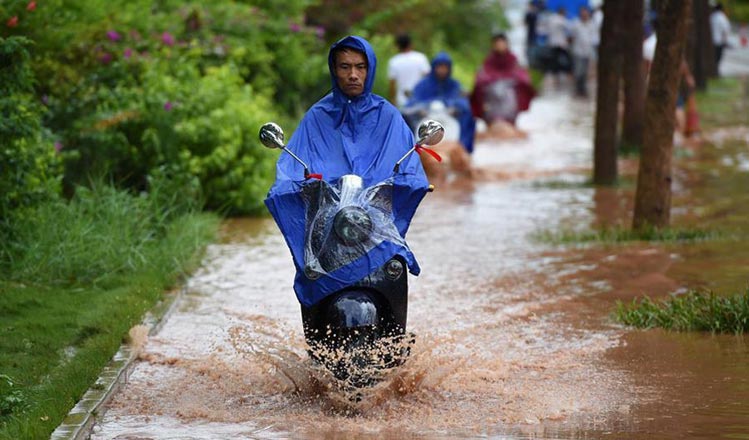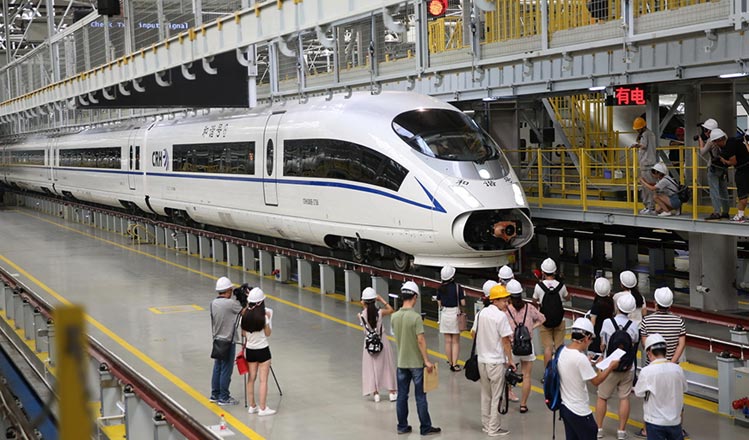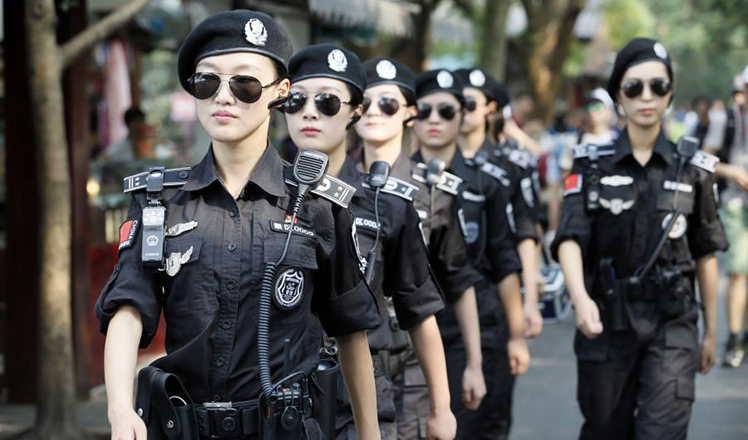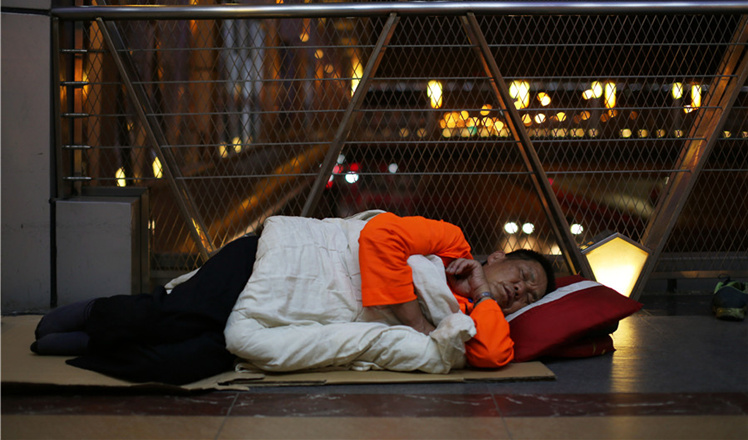'Sponge cities' soak up rain, pain
Updated: 2016-08-04 07:40
By Hu Meidong/Liu Kun/Hou Liqiang(China Daily)
|
||||||||
Early indications suggest that a government-backed campaign to increase the use of permeable materials in construction will help reduce flooding after storms, report Hu Meidong in Fuzhou, Liu Kun in Wuhan and Hou Liqiang in Beijing.
"In addition to an apartment and a car, newlyweds in Wuhan have just one more 'must-have' item for their new lives: a boat."
That's just one of dozens of jokes that went viral on the internet after downpours on July 6 flooded the capital of Hubei province, leaving many roads impassable. Pumps at 38 stations across the city worked around the clock to drain about 100 million cubic meters of water, but still failed to prevent severe flooding.
On average, from 2013 to 2015 about 180 cities nationwide suffered similar floods, so a serious question underpins all the jokes: How can we solve the problem?
Tests in pilot areas of Wuhan's "Sponge City" program, launched last year, suggest the project may provide an answer, but more still needs to be done, according to experts.
The program aims to allow at least 70 percent of rainwater to soak into the ground instead of being discharged into rivers. The designers plan to achieve the target by developing residential communities fitted with storage tanks, filtration pools and wetlands, and by building roads, sidewalks and squares from permeable materials.
In April last year, the central government selected 16 cities and districts across the country including Xiamen, Fujian province, and Wuhan as test grounds for the program. Each city was granted an annual subsidy of at least 400 million yuan ($60 million) over a three-year period. A further 14 cities were added to the program in April.
The pilot areas in Xiamen and Wuhan have reported good feedback. In Wuhan, the construction of 104 projects has started, buoyed by the investment of 2 billion yuan. Peng Bo, an official with the Wuhan commission of housing and urban-rural development, said the completed sections of the project performed efficiently during a heavy storm on June 11.
"The rain started at 8 am. By about 10 am it had escalated to a rainstorm that lasted until 2 or 3 pm. Without the sponge city facilities, the accumulated water would have started flowing from the area about 10 to 15 minutes after the rainstorm, but our monitoring found that the water only obviously began flowing out after 11:30 am," said Peng, quoted by China Newsweek.
If rainwater could be prevented from flowing out for an hour or even 30 minutes after a storm, it would help to reduce the amount of flooding, he added.
According to Zhang Jianming, deputy director of the sponge city development office in Xiamen, 236 projects are scheduled for completion by the end of next year, at a cost of more than 7,200 million yuan. By the end of May, a combined 2.96 square kilometers in 59 projects had been completed.
Water gardens
"No waterlogging has occurred in the reconstructed areas during the heavy rains so far this year, even though Xiamen was hit by Typhoon Nepartak (a category-5 super typhoon)," Zhang said.
"The function of the sponge city is huge in coping with urban flooding," he said.
As an example, he cited a project nearing completion.
On Dec 9, the area around Xinjing Road, which has been rebuilt with permeable materials and water gardens that operate as storage ponds, was hit by a lengthy downpour. While many roads in the area were flooded, the water around Xinjing Road subsided quickly.
"To promote the sponge city concept, we include information about it in primary school nature courses, with specially developed notebooks and display boards," Zhang said, adding that school-based facilities will be used to promote the project and encourage students to explore new approaches to sponge city construction.
Although Zhang stressed that the project will have to be completed before its effectiveness can be assessed, Peng, the official from Wuhan, was not optimistic about its ability to cope with severe storms.
He agreed that the initiative has been effective in relieving waterlogging in some cities, but said the problem will only really be solved by improvements in the design and construction of drainage systems.
"For cities in the south, whether a city will be flooded or not after heavy rainstorm still depends largely on its underground drainage system," he said. He added that the concept will only be truly effective when rivers, lakes and waterlogged areas are connected efficiently, allowing water to flow away from flooded districts.
"The contribution of each sponge in relieving waterlogging is limited, but if we can ensure they are well connected, every sponge could play its role," he said.
Peng's remarks were echoed by Wang Jiazhuo, a researcher with the China Academy of Urban Planning and Design, who is also a member of the expert committee guiding the construction of sponge cities. "While promoting the construction of sponge cities, we should also promote the construction of drainage systems and flood-prevention facilities," he told the business magazine Caijing.
Only the use of both measures would reduce urban flooding effectively, he said.
- Fire guts Emirates jet after hard landing; 1 firefighter dies
- Egypt's Nobel-laureate scientist dies of illness in US
- THAAD muscle flexing unmasks anxiety over declining hegemony
- British police say mental health a significant factor in London knife attack
- Paragliding fans fly over Rigi mountain in Switzerland
- DPRK fires 1 ballistic missile into east waters

 After Typhoon Nida, torrential rain hits S. China
After Typhoon Nida, torrential rain hits S. China
 World's fastest bullet train to start operating next month
World's fastest bullet train to start operating next month
 Serbian artist creates incredible 3-D art
Serbian artist creates incredible 3-D art
 Glimpse into the work and life of G20 guards
Glimpse into the work and life of G20 guards
 Shopping and throwing Frisbee in virtual reality
Shopping and throwing Frisbee in virtual reality
 Take a closer look at the life in Rio Olympic Village
Take a closer look at the life in Rio Olympic Village
 From dusk to dawn: The other side of Beijing
From dusk to dawn: The other side of Beijing
 Huangluo: China's 'long hair village'
Huangluo: China's 'long hair village'
Most Viewed
Editor's Picks

|

|

|

|

|

|
Today's Top News
US launches airstrikes against IS targets in Libya's Sirte
Ministry slams US-Korean THAAD deployment
Two police officers shot at protest in Dallas
Abe's blame game reveals his policies failing to get results
Ending wildlife trafficking must be policy priority in Asia
Effects of supply-side reform take time to be seen
Chinese State Councilor Yang Jiechi to meet Kerry
Chinese stocks surge on back of MSCI rumors
US Weekly

|

|







